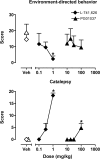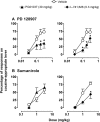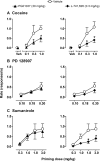Dopamine D3 and D2 receptor mechanisms in the abuse-related behavioral effects of cocaine: studies with preferential antagonists in squirrel monkeys
- PMID: 20494958
- PMCID: PMC2913766
- DOI: 10.1124/jpet.110.167619
Dopamine D3 and D2 receptor mechanisms in the abuse-related behavioral effects of cocaine: studies with preferential antagonists in squirrel monkeys
Abstract
Dopamine (DA) D3 and D2 receptor mechanisms are implicated in cocaine's abuse-related behavioral effects, but the relative contribution of the two receptor subtypes is only partially characterized. This study investigated the role of D3 and D2 subtype mechanisms by determining the degree to which the D3-preferring antagonist PG01037 [N-{4-[4-(2,3-dichlorophenyl)-piperazin- 1-yl]-trans-but-2-enyl}-4-pyridine-2-yl-benzamide HCl] and the D2-preferring antagonist L-741626 [3-[4-(4-chlorophenyl)-4- hydroxypiperidin-1-yl]methyl-1H-indole] attenuated several behavioral effects of cocaine in squirrel monkeys. Quantitative observational studies established doses of each antagonist that did not produce untoward effects, which were used in subsequent comparisons. In addition, the ability of the D3-preferring agonist PD128907 [(R-(+)-trans-3,4a,10b-tetrahydro-4-propyl-2H,5H-[1]benzopyrano[4,3-b]-1,4-oxazin-9-ol)] and the D2-preferring agonist sumanirole [(R)-5,6-dihydro-5-(methylamino)-4H- imidazo[4,5,1-ij]quinolin-2(1H)-one(Z)-2-butenedioate] to reproduce cocaine's discriminative stimulus (DS) and priming effects were compared. In monkeys trained to discriminate cocaine from vehicle, both DA antagonists attenuated and both DA agonists partially reproduced cocaine's DS effects. PG01037 also selectively attenuated the cocaine-like DS effects of PD128907, whereas L-741626 attenuated the cocaine-like DS effects of both agonists. In self-administration studies, L-741626 nonselectively reduced cocaine- and food-maintained responding, whereas PG01037 was ineffective against either reinforcer. In studies involving reinstatement of extinguished cocaine seeking, both antagonists attenuated cocaine-induced reinstatement of responding, and both agonists induced at least partial reinstatement of cocaine seeking. L-741626 also attenuated sumanirole-induced, but not PD128907-induced, reinstatement of responding, whereas PG01037 was ineffective against either DA agonist. The results are consistent with a role for D3 and D2 receptor mechanisms in cocaine's DS effects and cocaine-induced reinstatement of drug seeking, but provide no evidence for a major role of D3 receptors in the direct reinforcing effects of cocaine.
Figures







References
-
- Acri JB, Carter SR, Alling K, Geter-Douglass B, Dijkstra D, Wikström H, Katz JL, Witkin JM. (1995) Assessment of cocaine-like discriminative stimulus effects of dopamine D3 receptor ligands. Eur J Pharmacol 281:R7–R9 - PubMed
-
- Besson M, Belin D, McNamara R, Theobald DE, Castel A, Beckett VL, Crittenden BM, Newman AH, Everitt BJ, Robbins TW, et al. (2010) Dissociable control of impulsivity in rats by dopamine d2/3 receptors in the core and shell subregions of the nucleus accumbens. Neuropsychopharmacology 35:560–569 - PMC - PubMed
Publication types
MeSH terms
Substances
Grants and funding
LinkOut - more resources
Full Text Sources
Other Literature Sources
Medical

